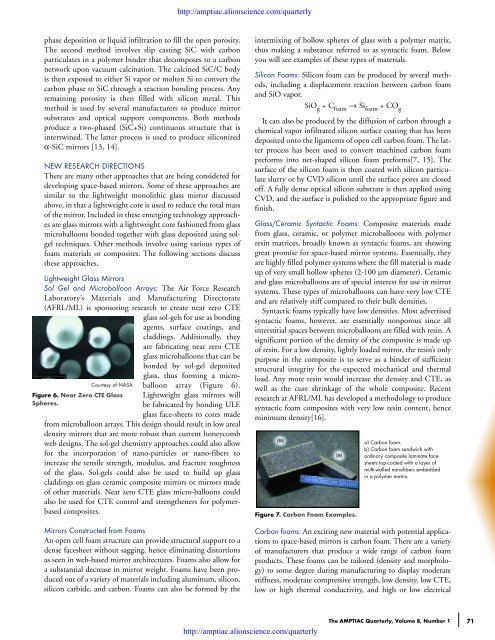Advanced Materials and Processes for Large, Lightweight, Space ...
Advanced Materials and Processes for Large, Lightweight, Space ...
Advanced Materials and Processes for Large, Lightweight, Space ...
- No tags were found...
You also want an ePaper? Increase the reach of your titles
YUMPU automatically turns print PDFs into web optimized ePapers that Google loves.
phase deposition or liquid infiltration to fill the open porosity.The second method involves slip casting SiC with carbonparticulates in a polymer binder that decomposes to a carbonnetwork upon vacuum calcination. The calcined SiC/C bodyis then exposed to either Si vapor or molten Si to convert thecarbon phase to SiC through a reaction bonding process. Anyremaining porosity is then filled with silicon metal. Thismethod is used by several manufacturers to produce mirrorsubstrates <strong>and</strong> optical support components. Both methodsproduce a two-phased (SiC+Si) continuous structure that isintertwined. The latter process is used to produce siliconizedα-SiC mirrors [13, 14].NEW RESEARCH DIRECTIONSThere are many other approaches that are being considered <strong>for</strong>developing space-based mirrors. Some of these approaches aresimilar to the lightweight monolithic glass mirror discussedabove, in that a lightweight core is used to reduce the total massof the mirror. Included in these emerging technology approachesare glass mirrors with a lightweight core fashioned from glassmicroballoons bonded together with glass deposited using solgeltechniques. Other methods involve using various types offoam materials or composites. The following sections discussthese approaches.<strong>Lightweight</strong> Glass MirrorsSol Gel <strong>and</strong> Microballoon Arrays: The Air Force ResearchLaboratory’s <strong>Materials</strong> <strong>and</strong> Manufacturing Directorate(AFRL/ML) is sponsoring research to create near zero CTEglass sol-gels <strong>for</strong> use as bondingagents, surface coatings, <strong>and</strong>claddings. Additionally, theyare fabricating near zero CTEglass microballoons that can bebonded by sol-gel depositedCourtesy of NASAFigure 6. Near Zero CTE GlassSpheres.glass, thus <strong>for</strong>ming a microballoonarray (Figure 6).<strong>Lightweight</strong> glass mirrors willbe fabricated by bonding ULEglass face-sheets to cores madefrom microballoon arrays. This design should result in low arealdensity mirrors that are more robust than current honeycombweb designs. The sol-gel chemistry approaches could also allow<strong>for</strong> the incorporation of nano-particles or nano-fibers toincrease the tensile strength, modulus, <strong>and</strong> fracture toughnessof the glass. Sol-gels could also be used to build up glasscladdings on glass ceramic composite mirrors or mirrors madeof other materials. Near zero CTE glass micro-balloons couldalso be used <strong>for</strong> CTE control <strong>and</strong> strengtheners <strong>for</strong> polymerbasedcomposites.Mirrors Constructed from FoamsAn open cell foam structure can provide structural support to adense facesheet without sagging, hence eliminating distortionsas seen in web-based mirror architectures. Foams also allow <strong>for</strong>a substantial decrease in mirror weight. Foams have been producedout of a variety of materials including aluminum, silicon,silicon carbide, <strong>and</strong> carbon. Foams can also be <strong>for</strong>med by theintermixing of hollow spheres of glass with a polymer matrix,thus making a substance referred to as syntactic foam. Belowyou will see examples of these types of materials.Silicon Foams: Silicon foam can be produced by several methods,including a displacement reaction between carbon foam<strong>and</strong> SiO vapor.SiO g + C foam → Si foam + CO gIt can also be produced by the diffusion of carbon through achemical vapor infiltrated silicon surface coating that has beendeposited onto the ligaments of open cell carbon foam. The latterprocess has been used to convert machined carbon foampre<strong>for</strong>ms into net-shaped silicon foam pre<strong>for</strong>ms[7, 15]. Thesurface of the silicon foam is then coated with silicon particulateslurry or by CVD silicon until the surface pores are closedoff. A fully dense optical silicon substrate is then applied usingCVD, <strong>and</strong> the surface is polished to the appropriate figure <strong>and</strong>finish.Glass/Ceramic Syntactic Foams: Composite materials madefrom glass, ceramic, or polymer microballoons with polymerresin matrices, broadly known as syntactic foams, are showinggreat promise <strong>for</strong> space-based mirror systems. Essentially, theyare highly filled polymer systems where the fill material is madeup of very small hollow spheres (2-100 µm diameter). Ceramic<strong>and</strong> glass microballoons are of special interest <strong>for</strong> use in mirrorsystems. These types of microballoons can have very low CTE<strong>and</strong> are relatively stiff compared to their bulk densities.Syntactic foams typically have low densities. Most advertisedsyntactic foams, however, are essentially nonporous since allinterstitial spaces between microballoons are filled with resin. Asignificant portion of the density of the composite is made upof resin. For a low density, lightly loaded mirror, the resin’s onlypurpose in the composite is to serve as a binder of sufficientstructural integrity <strong>for</strong> the expected mechanical <strong>and</strong> thermalload. Any more resin would increase the density <strong>and</strong> CTE, aswell as the cure shrinkage of the whole composite. Recentresearch at AFRL/ML has developed a methodology to producesyntactic foam composites with very low resin content, henceminimum density[16].Figure 7. Carbon Foam Examples.a) Carbon foam.b) Carbon foam s<strong>and</strong>wich withordinary composite laminate facesheetstop-coated with a layer ofmulti-walled nanofibers embeddedin a polymer matrix.Carbon foams: An exciting new material with potential applicationsto space-based mirrors is carbon foam. There are a varietyof manufacturers that produce a wide range of carbon foamproducts. These foams can be tailored (density <strong>and</strong> morphology)to some degree during manufacturing to display moderatestiffness, moderate compressive strength, low density, low CTE,low or high thermal conductivity, <strong>and</strong> high or low electricalThe AMPTIAC Quarterly, Volume 8, Number 1 71
















